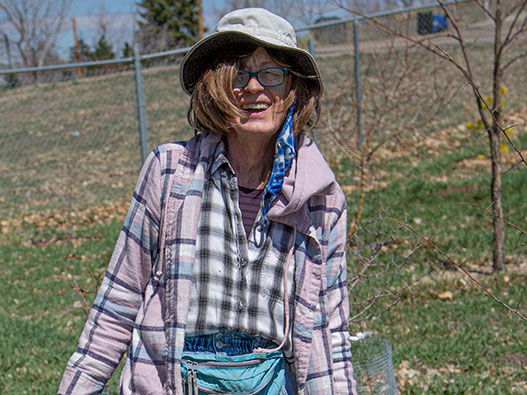Regis’ Tree Whisperer Helps Diverse Species Take Root
Listen to the audio version of this article
Tucked away on the eastern side of the Northwest Denver Campus and fenced off from the rest of the world, more than 100 young trees are protected and cared for in a nursery until they are big and strong enough to become part of Regis’ celebrated arboretum.
Much of that care is provided by the woman who paid for many of them out of her own pocket, who has given countless hours to planting, growing and tending Regis trees, and for whom that secluded nursery is now named: Sonia John.
Since 2015, John, a retired artist and local tree lover, has lent her self-described “tree energies” to the Regis University arboretum. But her interest in trees took root long before she set foot on campus and saw hundreds of species thriving despite Denver’s dry, tree-hostile climate.

“When I was a kid, I’d climb trees, but doesn’t everybody climb trees?” John said. She remembers growing up around maple trees and their winged seeds, which spun like helicopter blades on their way to the ground. And she remembers collecting foliage in high school for a biology class assignment. Using a key that asked about distinguishing features — Was the leaf veined? Symmetrical? Were its edges smooth or jagged? — she learned to identify a tree based on its leaves.
That skill stuck with her. Decades later, on a walk in Denver, a friend pointed out a tree. John could tell it was an oak, but her friend wanted to know what kind of oak. John didn’t know.
At home, she flipped through a book about North American trees, skimming its pages of oak listings to identify the mystery oak. To no avail. Not until John took to the internet could she identify the tree: It was an English Oak. Not a species native to North America. “Oh, so oaks from other parts of the world are grown here,” she remembers thinking. It seems silly to her now, but in the moment, the realization was like a match taking light. And it lit her curiosity like dry tinder. I’ve got to find out more.
That was in 2004. Since then, John has become both tree expert and tree nurturer. She turned her patio and backyard into her own mini greenhouse and nursery. She volunteered with the University of Denver’s campus arboretum. She started an annual Tree Diversity Conference in partnership with Denver Botanic Gardens. She’s traveled the globe to visit arboretums in New Zealand, France, Spain and England. She’s developed relationships in the world of tree lovers and enthusiasts. And for more than five years, she has supported the Regis University Arboretum as its volunteer curator.
Officially designated since 2000, the Regis University Arboretum encompasses the entire Denver campus tree collection, from the state champion Weeping American Elm near O’Connell Hall that turns a stunning yellow in the fall to the Sawtooth Oak that is one of a handful of trees lining Boettcher Commons. The Arboretum started informally in the mid-80s with the efforts of Jack Callahan, a Jesuit priest who took it upon himself to start planting trees on campus.
When Patrick Schlanger, director of physical plant operations, started as a landscaper at Regis in 1991, the Arboretum was talked about a lot, but there wasn’t any real energy behind making it official—not until nine years later, when a donation from alumnus Martin Hart provided resources to identify and label the trees, create maps of their locations, and build a kiosk for the maps. (The kiosk is located near the sidewalk directly across from Parking Lot 4.) Currently, a small endowment provides enough funding to purchase a few trees each year, keep them labeled, and update the arboretum maps.
Before John started volunteering at Regis, Schlanger’s team added five to 10 new species of trees to the Arboretum each year. They set up a small nursery so trees could build some girth before being exposed to errant frisbees and other hazards on the broader campus.
“When Sonia became the curator, [the planting] accelerated,” Schlanger said. Now, they add 15 to 25 species annually, some purchased by John and replanted from her backyard nursery. “Given her knowledge and her networking through the tree world, we are more easily able to get new varieties.”
According to John, the Regis University Arboretum currently contains 328 different species. They line the outer edge of campus. They stand along the outfield of the baseball field. They provide depth to Our Lady of Loretto Grotto and a canopy over benches and boulders across campus.
In the nursery, where John keeps an eye on the irrigation system and clears out weeds and bug infestations, more trees wait to join the arboretum. When a tree is ready for its permanent home, John and Schlanger drive a cart around campus and size up potential planting spots. Is there too much sun? Not enough? Too much wind for this type of tree?
“It’s so hard to grow trees here,” John said on a Wednesday in early March, when the high temperature was 61 degrees — a week and a half before a winter storm and three feet of snow effectively shut down northeastern Colorado. “For years, it was kind of the received wisdom ... that you can only grow this very restricted list of trees here because of lack of water, the intense sunshine, the very low temperatures and the drastic swings in temperature in the fall and spring. It’s just really hard on trees. And that is true, but they underestimated what could be grown here.”
With John’s help, the Regis University Arboretum is resetting expectations.